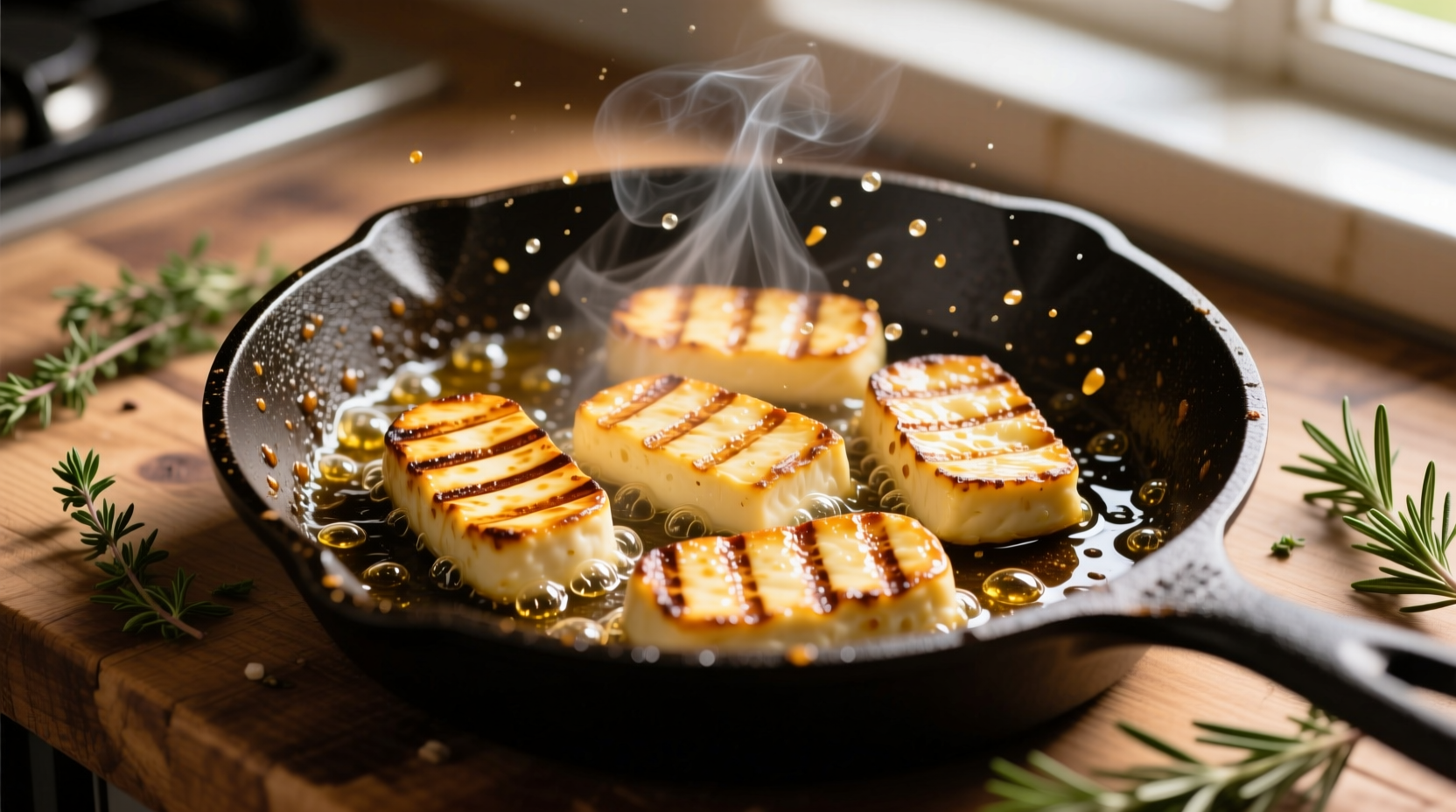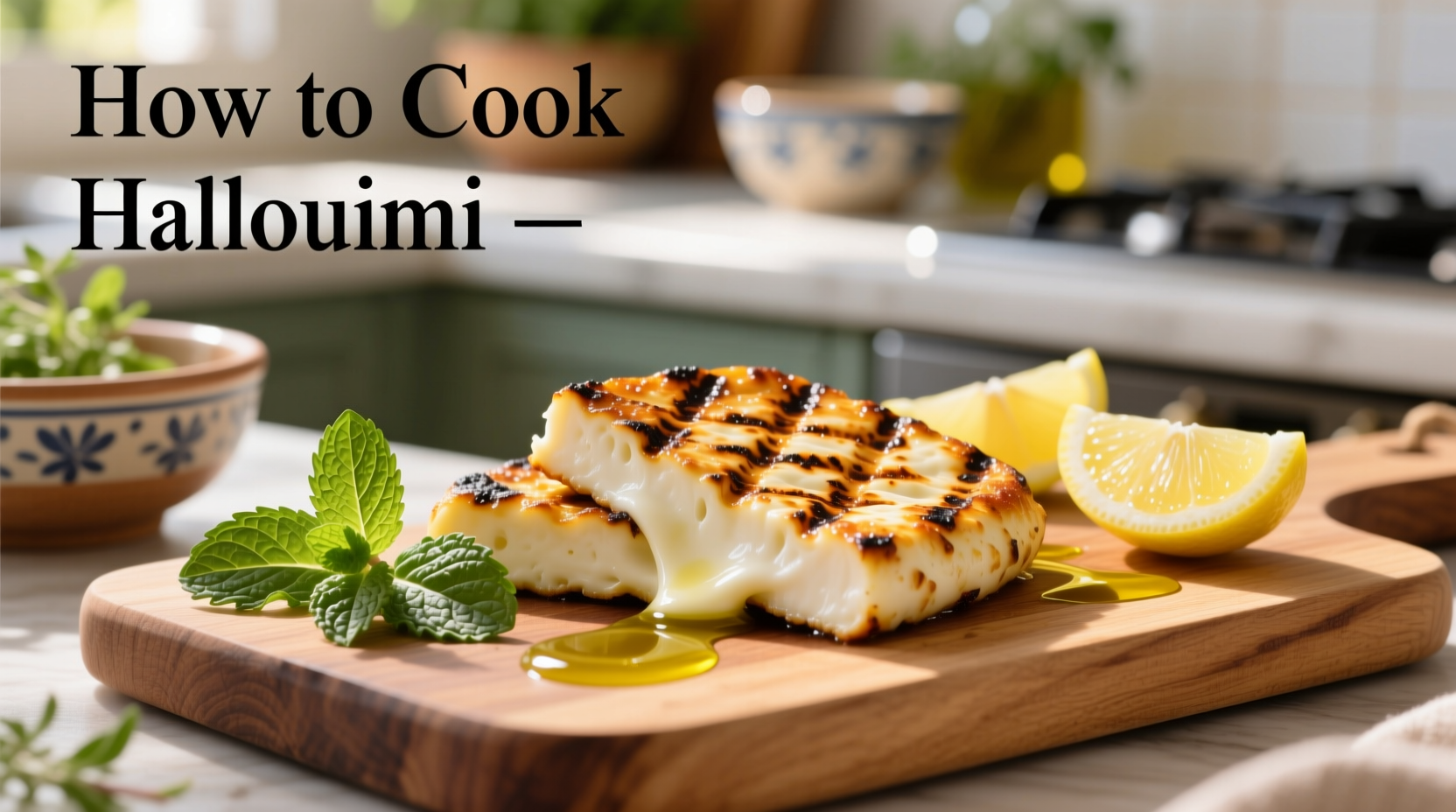Halloumi cheese is best cooked by slicing it 1/2 inch thick, patting dry, and pan-frying in a hot non-stick skillet for 2-3 minutes per side until golden brown. No additional oil is typically needed as halloumi releases its own fat when cooked. This simple method preserves its signature squeaky texture while creating a delicious golden crust.
Why Halloumi Stands Out Among Cooking Cheeses
Halloumi's unique composition makes it perfect for high-heat cooking. Unlike most cheeses that melt when heated, halloumi maintains its shape thanks to its higher melting point. This Cypriot specialty contains less acid and more calcium than typical cheeses, creating that distinctive "squeak" when bitten and allowing it to hold up to grilling, frying, and baking without losing its structure.
According to the Cyprus Ministry of Agriculture, authentic halloumi must contain at least 51% sheep's milk and up to 30% goat's milk, with the remainder being cow's milk. This specific blend contributes to its exceptional cooking properties and distinctive flavor profile that balances saltiness with a subtle tang.
Essential Preparation Steps for Perfect Halloumi
Before you start cooking halloumi cheese, proper preparation makes all the difference. Many beginners skip these crucial steps, resulting in soggy or unevenly cooked cheese.
Drying and Slicing Techniques
Remove halloumi from its packaging and gently pat each slice dry with paper towels. Excess moisture prevents proper browning. For best results when learning how to cook halloumi cheese, cut 1/2 inch thick slices—too thin and they'll become overly crispy; too thick and the center won't heat properly.
Pro tip: Soak overly salty halloumi in cold water for 10-15 minutes before cooking to mellow the saltiness, especially with budget-friendly supermarket varieties.
Four Reliable Methods for Cooking Halloumi Cheese
While pan-frying remains the most popular technique for how to cook halloumi cheese, each method offers distinct advantages depending on your equipment and desired outcome.
| Cooking Method | Temperature | Cooking Time | Best For |
|---|---|---|---|
| Pan-Frying | Medium-high heat | 2-3 minutes per side | Classic golden crust, squeaky interior |
| Grilling | Direct medium heat | 2-3 minutes per side | Smoky flavor, char marks |
| Baking | 400°F (200°C) | 10-12 minutes | Large batches, salad toppings |
| Air Frying | 375°F (190°C) | 6-8 minutes | Crisp texture with less oil |
Pan-Frying: The Gold Standard Method
Heat a non-stick or cast iron skillet over medium-high heat—no oil needed as halloumi releases its own fat. Place slices in the pan without overcrowding. Wait until golden brown crust forms (about 2-3 minutes) before flipping. The cheese should release easily when properly seared. Cook second side until golden. Remove immediately to prevent overcooking.
Avoid these common mistakes when learning how to cook halloumi cheese in a pan: moving the cheese too soon, using low heat (causes oil separation), or overcrowding the pan (creates steam instead of sear).
Grilling Halloumi for Summer Entertaining
Preheat grill to medium heat. Pat halloumi dry and brush lightly with olive oil. Place slices perpendicular to grates to prevent falling through. Grill 2-3 minutes per side until distinct grill marks appear and cheese holds its shape. The high heat creates beautiful char without compromising the interior texture.
Grilled halloumi works particularly well for summer entertaining as it maintains its shape and doesn't require last-minute attention like some proteins.
Perfect Pairings and Serving Suggestions
Cooked halloumi shines when paired thoughtfully. The saltiness balances beautifully with:
- Fresh watermelon and mint (classic Cypriot combination)
- Lemon-herb salad with cherry tomatoes and cucumber
- Roasted vegetables like zucchini, bell peppers, and eggplant
- Honey drizzle and crushed pistachios for a sweet-savory contrast
For breakfast applications when learning how to cook halloumi cheese for morning meals, try it alongside scrambled eggs and avocado. The cheese's firm texture holds up well to various cooking methods while providing a satisfying protein boost.

Avoiding Common Halloumi Cooking Mistakes
Even experienced cooks make these errors when preparing halloumi:
Overcooking Halloumi
Unlike proteins that need time to cook through, halloumi only needs surface browning. Extended cooking makes it tough and rubbery rather than maintaining that desirable squeaky texture. Remove from heat as soon as both sides develop a golden crust.
Misunderstanding Salt Content
Halloumi's saltiness varies significantly by brand. Before adding additional salt to your dish, taste a small piece of cooked halloumi. Many commercial varieties contain enough salt that no additional seasoning is needed.
Ignoring Temperature Transitions
Take halloumi out of the refrigerator 15-20 minutes before cooking. Cold cheese straight from the fridge is more likely to break apart when handled and won't brown as evenly. Room temperature halloumi responds better to high-heat cooking methods.
Storing and Reheating Leftover Cooked Halloumi
Store cooked halloumi in an airtight container in the refrigerator for up to 3 days. For best results when reheating cooked halloumi:
- Skillet method: Heat in dry pan over medium heat for 1-2 minutes per side
- Oven method: 350°F (175°C) for 5-7 minutes until warmed through
- Avoid microwaving: Creates uneven texture and makes halloumi rubbery
Uncooked halloumi keeps well in its brine for up to two weeks refrigerated. Change the water every few days to maintain freshness if storing long-term.
When Halloumi Isn't the Right Choice
While versatile, halloumi has specific limitations. Understanding these context boundaries helps you make better cooking decisions:
- Melting applications: Halloumi won't melt like mozzarella or cheddar, so avoid using it in dishes where melted cheese is essential
- Delicate dishes: Its strong flavor can overwhelm subtle ingredients in light pasta dishes or creamy sauces
- Low-sodium diets: Even after soaking, halloumi remains relatively high in sodium compared to other cheeses
For dishes requiring melted cheese, consider using halloumi as a garnish rather than the primary cheese component. Its unique texture makes it ideal for dishes where you want visible cheese elements that maintain their shape during cooking.
Frequently Asked Questions
Do I need to add oil when cooking halloumi?
No, additional oil isn't necessary when cooking halloumi cheese. The cheese contains enough fat that it releases natural oils when heated. Adding extra oil can cause splattering and prevent proper browning. Only use a light brush of oil if grilling to prevent sticking to the grates.
Why does my halloumi break apart when I cook it?
Halloumi breaks apart when cooked if it's too cold from the refrigerator, sliced too thin, or handled too soon after placing in the pan. Allow cheese to come to room temperature for 15-20 minutes before cooking, cut 1/2 inch thick slices, and wait until a golden crust forms (about 2 minutes) before attempting to flip.
Can you bake halloumi instead of frying it?
Yes, baking is an excellent alternative method for cooking halloumi cheese. Preheat oven to 400°F (200°C), arrange slices on a parchment-lined baking sheet, and bake for 10-12 minutes until golden and slightly puffed. Baking works particularly well for preparing larger quantities without the need for constant attention required with pan-frying.
How do I reduce the saltiness of halloumi?
To reduce saltiness when cooking halloumi cheese, soak slices in cold water for 10-15 minutes before cooking. For stronger results, change the water 2-3 times during soaking. Avoid soaking longer than 30 minutes as this can affect texture. Alternatively, choose low-salt varieties specifically labeled as such when purchasing.
What's the best way to store leftover cooked halloumi?
Store cooked halloumi in an airtight container in the refrigerator for up to 3 days. Place parchment paper between slices to prevent sticking. Reheat in a dry skillet over medium heat for 1-2 minutes per side for best results. Avoid microwaving as it creates an unpleasant rubbery texture.











 浙公网安备
33010002000092号
浙公网安备
33010002000092号 浙B2-20120091-4
浙B2-20120091-4